To master Shopify dropshipping, start with thorough research and choose a profitable niche. Set up your Shopify store and source reliable suppliers.
Starting a Shopify dropshipping business can be a lucrative venture if done correctly. Dropshipping allows you to sell products without holding inventory, making it a low-risk option for beginners. The key to success lies in selecting the right niche, finding trustworthy suppliers, and optimizing your Shopify store for conversions.
By leveraging the power of digital marketing and SEO, you can attract a steady stream of traffic to your store. Consistent effort, strategic planning, and staying updated with industry trends will help you build a profitable dropshipping business on Shopify.
Introduction To Shopify Dropshipping
Dropshipping is a popular way to start an online business. With Shopify, you can easily set up your dropshipping store. This guide will help you understand how to master Shopify dropshipping as a beginner.
What Is Dropshipping?
Dropshipping is a retail method where you don’t keep products in stock. Instead, you sell products, and a third-party supplier ships them to customers. You don’t need to worry about inventory or shipping. Your main job is to market and sell products.
This model has many benefits. It requires low investment and has minimal risk. You can start a business with little money. You only pay for products when you sell them. This makes it easy to test different products and niches.
Why Choose Shopify?
Shopify is one of the best platforms for dropshipping. It is easy to use and beginner-friendly. Here are some reasons to choose Shopify:
- User-Friendly Interface: Shopify is easy to navigate.
- Customizable Themes: You can choose from many themes to design your store.
- App Integrations: Shopify has many apps that help with dropshipping.
- Secure and Reliable: Shopify provides a secure shopping experience.
Here is a table summarizing the benefits of using Shopify for dropshipping:
| Benefit | Description |
|---|---|
| User-Friendly Interface | Shopify is easy to navigate and set up. |
| Customizable Themes | Choose from many themes to design your store. |
| App Integrations | Many apps help with dropshipping tasks. |
| Secure and Reliable | Shopify offers a secure shopping experience for customers. |
With Shopify, you can start your dropshipping journey easily. It offers many tools and support to help you succeed. Now, let’s dive deeper into how you can master Shopify dropshipping.
Setting Up Your Shopify Store
Setting up your Shopify store is the first step to mastering dropshipping. This process involves several key steps. Each step ensures your store runs smoothly and looks professional.
Creating Your Account
First, visit the Shopify website. Click on the “Start Free Trial” button. Enter your email address, password, and store name. Click “Create Your Store” to proceed. Shopify will ask a few questions. Answer them to help customize your experience.
Next, you will reach your Shopify admin dashboard. Here, you can manage your store. Familiarize yourself with this dashboard. It is your control center.
Choosing A Theme
Your store’s theme defines its look and feel. Shopify offers free and paid themes. Go to the “Online Store” section in your dashboard. Click on “Themes”. Browse through the available themes.
Select a theme that matches your brand. Click on the theme you like. Preview the theme to see how it looks. If satisfied, click “Add Theme”. Customize the theme to fit your brand’s identity.
Here are some tips for choosing a theme:
- Ensure it is responsive for mobile users.
- Pick a theme with good reviews.
- Choose a theme that aligns with your product type.
After setting up your theme, personalize your store. Add your logo, adjust colors, and change fonts. This will make your store unique.
Finding The Right Products
Choosing the right products is crucial for your Shopify dropshipping success. Without the right products, you won’t attract customers or make sales. This section will guide you on how to find those winning items.
Product Research Tools
Using the right tools can make product research easier and more effective. Here are some popular product research tools:
- Oberlo: A Shopify app that helps you find products and suppliers.
- AliExpress: A huge marketplace where you can find trending products.
- Google Trends: Shows you what people are searching for online.
- SaleHoo: Provides a directory of trusted suppliers and trending products.
These tools can help you identify popular and trending items. Use them to stay ahead of the competition.
Niche Selection Tips
Choosing a niche is a vital part of dropshipping. A niche is a specific segment of the market. Here are some tips for selecting a niche:
- Passion and Interest: Pick a niche you are passionate about. It will keep you motivated.
- Market Demand: Use tools like Google Trends to check the demand for products in your niche.
- Competition: Research your competitors to understand the market landscape. High competition might mean high demand, but it also means more effort to stand out.
- Profit Margins: Calculate potential profits. Ensure your niche offers good profit margins.
Following these tips will help you choose a profitable and enjoyable niche. A well-chosen niche can make your dropshipping business more successful.
Sourcing Suppliers
One of the most crucial aspects of mastering Shopify dropshipping is sourcing suppliers. The right suppliers can make or break your business. They ensure product quality and timely delivery. This section will guide you through finding reliable suppliers. You’ll learn to use AliExpress and build strong supplier relationships.
Using Aliexpress
AliExpress is a popular platform for sourcing products. It’s easy to use and has a vast selection. To get started:
- Create an account on AliExpress.
- Search for products related to your niche.
- Check product reviews and ratings.
- Compare prices from different suppliers.
- Contact suppliers directly to ask questions.
Look for suppliers with high ratings and positive feedback. This ensures you’re getting quality products. Use filters to narrow down your search. Pay attention to shipping times and costs. Always order samples before listing products in your store.
Building Supplier Relationships
Building relationships with suppliers is key to success. Good communication fosters trust and reliability. Here’s how to build strong supplier relationships:
- Communicate Clearly: Always be clear about your needs and expectations.
- Be Professional: Treat suppliers with respect and professionalism.
- Negotiate Prices: Don’t be afraid to ask for better prices.
- Pay on Time: Ensure timely payments to build trust.
- Provide Feedback: Give constructive feedback on product quality and service.
Consider using a table to track supplier information:
| Supplier Name | Contact Information | Product Quality | Shipping Time | Price |
|---|---|---|---|---|
| Supplier A | Email, Phone | High | Fast | Moderate |
| Supplier B | Email, Phone | Medium | Slow | Low |
Building strong relationships can lead to better deals and faster shipping. It’s worth investing time in these relationships. Reliable suppliers help your business run smoothly. Happy customers mean repeat business and growth.
Optimizing Your Store
To succeed in Shopify dropshipping, optimizing your store is essential. It helps to drive traffic and increase sales. This guide covers crucial optimization strategies.
SEO Best Practices
Search engine optimization (SEO) is vital for your store’s visibility. Use relevant keywords in product titles and descriptions. Add alt text to images using keywords. This improves search rankings.
Create unique content for your product pages. Avoid copying descriptions from suppliers. Unique content helps in search engine rankings. Also, use meta descriptions to entice clicks from search results.
Ensure your site loads quickly. Faster websites rank higher on search engines. Use tools like Google PageSpeed Insights to check your site speed. Optimize images and use a reliable hosting service.
User Experience Tips
User experience (UX) is crucial for conversion rates. A well-designed store makes shopping easy. Ensure your site is mobile-friendly. Many users shop on mobile devices.
Organize your products into clear categories. This helps users find what they need quickly. Use a simple, clean design. Avoid cluttering your pages with too many elements.
Include a search bar on your site. This helps users find products faster. Make sure the search function works well. Use high-quality images for your products. Clear images help users decide to buy.
Provide detailed product descriptions. Include all necessary information about the product. This reduces customer queries and returns.
Use customer reviews and ratings. They build trust and encourage purchases. Make sure the review system is easy to use.
Ensure a smooth checkout process. Offer multiple payment options. Make it easy for users to complete their purchases. A complicated checkout process can lead to abandoned carts.
| Optimization Area | Action | Benefit |
|---|---|---|
| SEO | Use keywords, alt text, meta descriptions | Higher search rankings |
| Site Speed | Optimize images, reliable hosting | Faster load times |
| Mobile-Friendly | Responsive design | Better user experience |
| Product Organization | Clear categories | Easy navigation |
| Checkout Process | Multiple payment options | Fewer abandoned carts |
Marketing Strategies
Effective marketing strategies are key to mastering Shopify dropshipping. They help you attract and retain customers. This section covers two powerful methods: social media marketing and email campaigns.
Social Media Marketing
Social media platforms are excellent for promoting your dropshipping store. They offer vast audiences and diverse tools. Here are some strategies to leverage social media:
- Create Engaging Content: Share high-quality images and videos of your products.
- Utilize Hashtags: Use relevant hashtags to reach a broader audience.
- Run Ads: Invest in targeted social media ads to boost visibility.
- Collaborate with Influencers: Partner with influencers to promote your products.
Choosing the right platform is also crucial. Facebook, Instagram, and Pinterest are popular for e-commerce. Tailor your strategy to each platform’s strengths.
Email Campaigns
Email campaigns are another powerful tool. They help you build relationships with your customers. Here are some tips to create effective email campaigns:
- Build an Email List: Collect emails through pop-ups and sign-up forms.
- Segment Your Audience: Group your email list based on customer behavior.
- Personalize Your Emails: Use the recipient’s name and tailor content to their interests.
- Offer Value: Share discounts, product updates, and exclusive content.
Email marketing tools like Mailchimp and Klaviyo can help automate your campaigns. Consistent communication keeps your audience engaged and informed.
Managing Orders And Fulfillment
Efficiently managing orders and fulfillment is essential for a successful Shopify dropshipping business. It ensures customer satisfaction and repeat business. This guide will help you master the process.
Order Processing
Order processing is the first step in fulfilling customer orders. It involves several key tasks:
- Order Verification: Ensure payment is received and details are correct.
- Inventory Check: Confirm product availability with your supplier.
- Order Placement: Place the order with your supplier.
Use Shopify’s automated tools to streamline order processing:
- Automated Notifications: Inform customers about their order status.
- Order Tracking: Provide tracking numbers to customers.
Shipping Solutions
Shipping is crucial in dropshipping, affecting both cost and delivery time. Choose reliable shipping solutions to ensure timely delivery. Consider the following options:
| Shipping Method | Delivery Time | Cost |
|---|---|---|
| Standard Shipping | 7-14 days | Low |
| Expedited Shipping | 3-7 days | Medium |
| Express Shipping | 1-3 days | High |
Offer multiple shipping options to meet different customer needs. Consider using Shopify’s built-in shipping calculators to provide accurate shipping costs at checkout.
Partner with reliable shipping carriers to ensure prompt delivery. Popular carriers include USPS, FedEx, and DHL.
Managing orders and fulfillment effectively will enhance your Shopify dropshipping business. Use the tips above to optimize your process and ensure customer satisfaction.
Analyzing And Scaling
Analyzing and scaling are crucial steps in mastering Shopify dropshipping. Success in dropshipping relies on understanding performance metrics and expanding your business strategically. Let’s dive into the key aspects of analyzing and scaling your dropshipping store.
Tracking Performance
Tracking performance is essential for growth. Use Shopify’s analytics tools to monitor key metrics.
- Conversion Rate: The percentage of visitors who make a purchase.
- Average Order Value (AOV): The average amount spent per order.
- Customer Acquisition Cost (CAC): The cost to acquire a new customer.
- Customer Lifetime Value (CLV): The total revenue from a customer over time.
Regularly review these metrics to identify trends and areas for improvement.
| Metric | Importance | Actionable Insights |
|---|---|---|
| Conversion Rate | High | Optimize product pages and checkout process. |
| Average Order Value (AOV) | Medium | Upsell and cross-sell products. |
| Customer Acquisition Cost (CAC) | High | Refine marketing strategies. |
| Customer Lifetime Value (CLV) | High | Implement loyalty programs. |
Scaling Your Business
Scaling your business involves expanding your operations strategically. Here are some effective strategies:
- Automate Processes: Use apps to automate order fulfillment and customer service.
- Expand Product Range: Add new products to attract different customer segments.
- Invest in Marketing: Increase your budget for paid ads and influencer partnerships.
- Optimize Supply Chain: Work with reliable suppliers to ensure timely deliveries.
- Enhance Customer Experience: Improve your website speed and user interface.
By following these strategies, you can effectively scale your Shopify dropshipping business.
Common Challenges And Solutions
Starting a Shopify dropshipping business is exciting but challenging. You need to tackle some common issues to succeed. Here are solutions to help you overcome these hurdles.
Handling Returns
Returns can be tricky in dropshipping. They impact your business reputation and profitability. Here are steps to manage returns effectively:
- Clear Return Policy: Create a simple, clear return policy. Make it easy for customers to understand.
- Supplier Coordination: Work closely with your suppliers. Ensure they handle returns swiftly.
- Quick Refunds: Process refunds quickly. It builds trust and improves customer satisfaction.
Use this table for a quick overview:
| Return Issue | Solution |
|---|---|
| Complex Return Policy | Create a simple, clear policy. |
| Slow Supplier Response | Coordinate closely with suppliers. |
| Delayed Refunds | Process refunds quickly. |
Dealing With Competition
Competition in dropshipping is fierce. Stand out by following these tips:
- Unique Products: Choose unique products. Avoid overly saturated markets.
- Quality Content: Create high-quality product descriptions and images.
- Excellent Customer Service: Provide top-notch customer service. It makes a big difference.
Use these strategies to stay ahead:
- SEO Optimization: Optimize your store for search engines. Use relevant keywords.
- Social Proof: Display customer reviews and testimonials. It builds trust.
- Marketing: Invest in effective marketing strategies. Utilize social media and email campaigns.
Frequently Asked Questions
What Is Shopify Dropshipping?
Shopify dropshipping is a business model where you sell products without holding inventory. You list products on your Shopify store, and when a customer orders, a third-party supplier ships the product directly to them. This reduces upfront costs and inventory management.
How Do I Start Shopify Dropshipping?
To start Shopify dropshipping, sign up for a Shopify account. Choose a niche, find reliable suppliers, and add products to your store. Customize your store’s design and start marketing to attract customers. Regularly analyze and optimize your strategies for better results.
Is Shopify Dropshipping Profitable?
Yes, Shopify dropshipping can be profitable if done correctly. Focus on finding profitable niches, reliable suppliers, and effective marketing strategies. Keep track of expenses and constantly optimize your store to maximize profits. Success depends on your dedication and business acumen.
What Are The Best Dropshipping Niches?
The best dropshipping niches are those with high demand and low competition. Popular niches include health and wellness, fashion, beauty products, home decor, and tech gadgets. Research trends, use tools like Google Trends, and analyze competitors to choose a profitable niche.
Conclusion
Mastering Shopify dropshipping takes time and dedication. Follow these steps to build a profitable online store. Stay updated with trends and continuously optimize your strategies. With persistence, you can achieve success in Shopify dropshipping. Start today and watch your business grow.
Keep learning and adapting to stay ahead in the competitive market.











